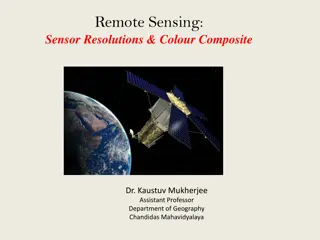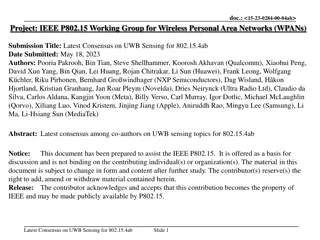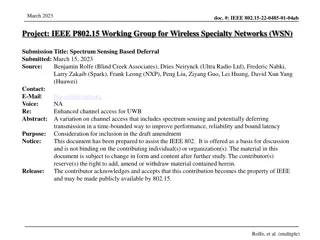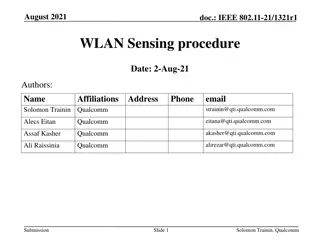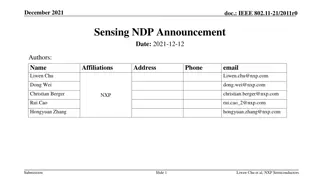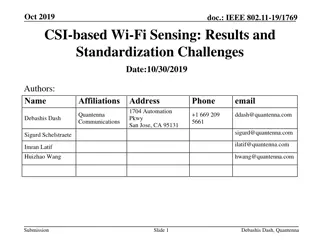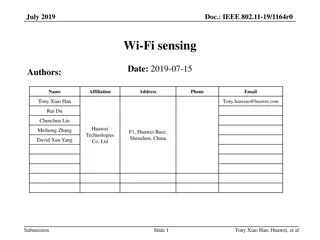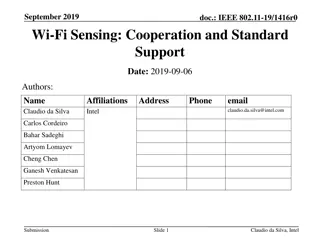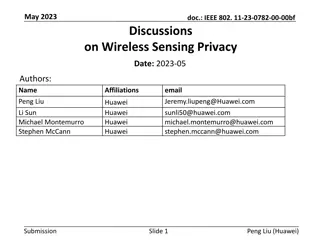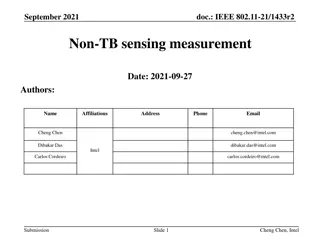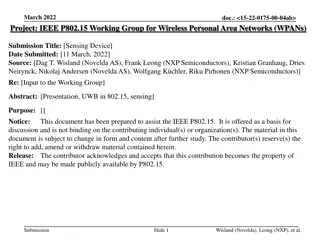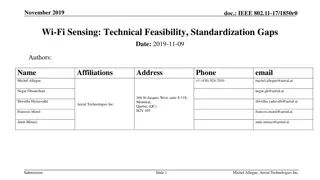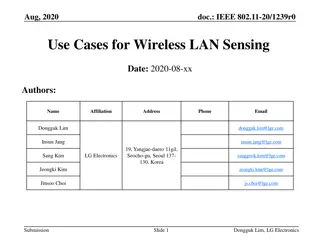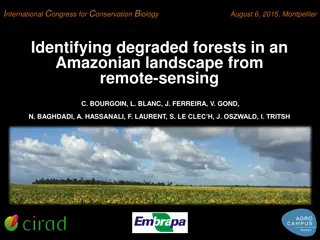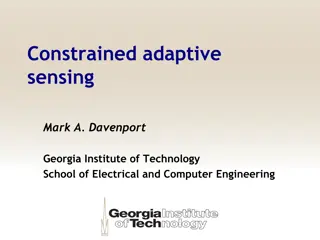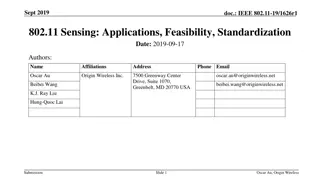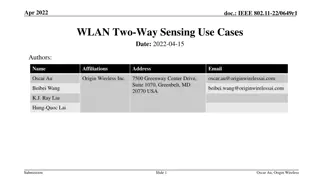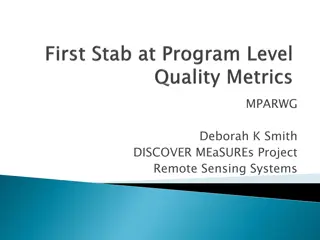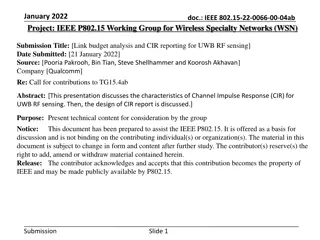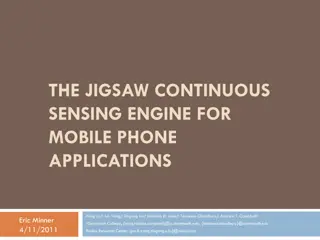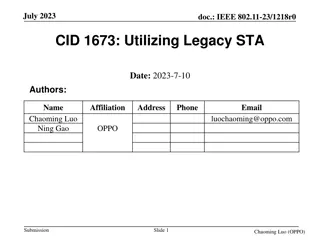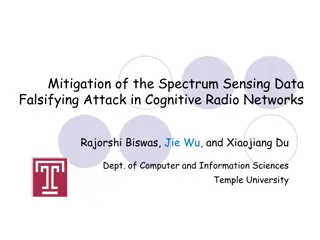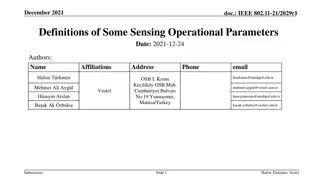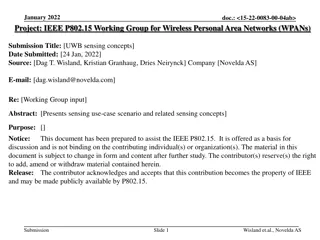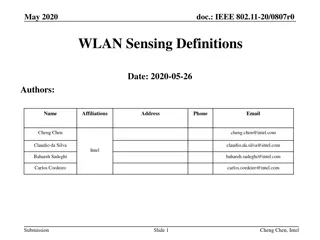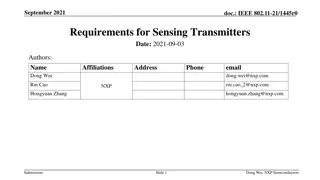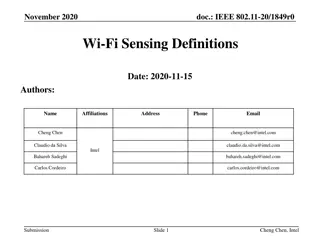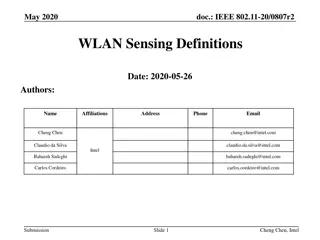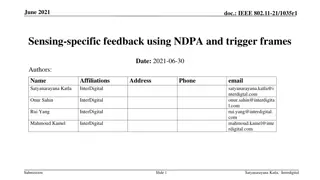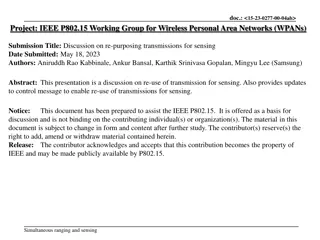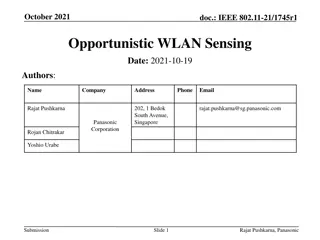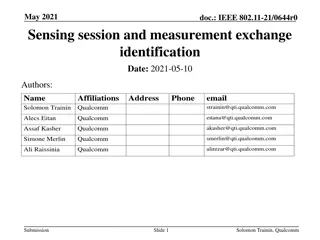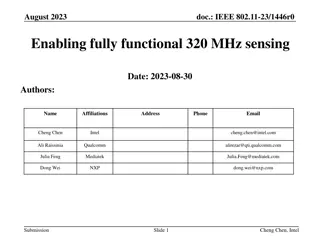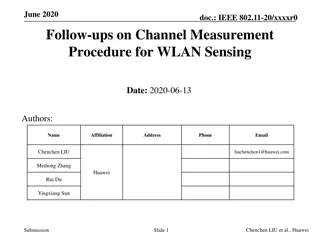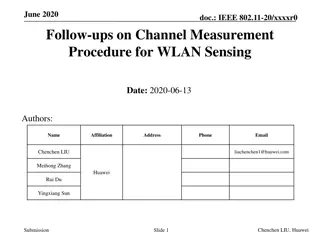Remote Sensing Sensor Resolutions & Colour Composite
Explore the art and science of remote sensing, detailing sensor types, resolution categories, and color composite techniques. Learn about the stages involved in remote sensing, sensor variations, and band designations for satellites like Landsat 8. Discover the significance of pixel, high-resolution
25 views • 13 slides
Latest Consensus on UWB Sensing for 802.15.4ab
Co-authors from various companies present the latest agreement on ultra-wideband (UWB) sensing topics for the IEEE 802.15.4ab standard. The consensus includes definitions for sensing pulse shape, packet formats for bi/multi-static sensing, and support for specific sequences and patterns in UWB sensi
13 views • 27 slides
Spectrum Sensing for Enhanced Channel Access in Wireless Networks
This document presents a proposal for Spectrum Sensing Based Deferral (SSBD) to improve channel access in wireless networks. SSBD incorporates spectrum sensing with transmission deferral in a time-bound manner to enhance performance, reliability, and latency control. The proposed solution safeguards
4 views • 11 slides
IEEE 802.11-21/1321r1 WLAN Sensing Procedure Proposal
This document by Solomon Trainin from Qualcomm presents a proposal on aligning the SFD for the WLAN sensing procedure. It aims to resolve contradictions, optimize behavior, and introduce a structured WLAN sensing procedure. The content outlines phases, terminology, setup, measurement, and reporting
2 views • 8 slides
IEEE 802.11-21/2011r0 Sensing NDP Announcement Overview
This document presents an overview of the IEEE 802.11-21/2011r0 Sensing NDP Announcement for utilizing NDP in sensing applications. It discusses the motivation behind NDP sensing, outlines the NDP Announcement frames, and explains possible sensing frame exchange sequences. The Ranging NDP Announceme
1 views • 8 slides
IEEE 802.11-19/1769: CSI-based Wi-Fi Sensing Results & Challenges
This document from Oct. 2019 explores IEEE 802.11-19/1769 CSI-based Wi-Fi sensing, focusing on results and standardization challenges. It delves into the concept of Wi-Fi sensing, its applications in security, automation, healthcare, and more, as well as the importance of CSI parameters such as reso
1 views • 10 slides
Wi-Fi Sensing in IoT: Advantages, Use Cases, and Challenges
Wi-Fi sensing utilizes Wi-Fi devices/network to detect presence, range, angle, and velocity of passive/non-transceiver objects. This document discusses the definition, advantages, use cases like smart home applications, and challenges of Wi-Fi sensing compared to other sensing technologies. It also
10 views • 15 slides
Exploring Wi-Fi Sensing for Motion Detection and Beyond
The document discusses the utilization of Wi-Fi signals for sensing various features in a given environment, such as motion, presence, gesture, and more, without assuming the subject carries a Wi-Fi device. It covers applications, technical principles, and a three-phase algorithm for motion detectio
3 views • 24 slides
Wireless Sensing Privacy Discussions in May 2023 Document
May 2023 document (.IEEE 802..11-23-0782-00-00bf) discusses privacy issues related to wireless sensing, including unauthorized access to sensing reports, tracking of sensing devices, and potential eavesdropping on sensing signals. It proposes solutions to protect sensitive information and addresses
4 views • 12 slides
Comparison of Trigger-based vs. Non-Trigger-based Sensing Measurement in IEEE 802.11
The document discusses the differences between Trigger-based (TB) and Non-Trigger-based (Non-TB) sensing measurement instances in IEEE 802.11 standards, focusing on who initiates the sensing measurement. TB sensing is initiated by the AP, while Non-TB sensing is initiated by a non-AP STA, enabling o
14 views • 13 slides
IEEE P802.15 WPAN Sensing Device Submission
This submission to the IEEE P802.15 Working Group focuses on the development of a sensing device for Wireless Personal Area Networks (WPANs). The document discusses the integration of Ultra-Wideband (UWB) technology for sensing applications, including presence detection and environment mapping. Key
4 views • 16 slides
Exploring Wi-Fi Sensing: Feasibility and Standardization Gaps
Delve into the technical aspects of Wi-Fi sensing, discussing its definition, feasibility, and standardization gaps according to the IEEE 802.11 standard. The presentation highlights the ability of Wi-Fi systems to detect environmental changes and explores scientific publications related to Wi-Fi se
3 views • 27 slides
Wireless LAN Sensing Use Cases in Home Environments
The document discusses use cases for Wireless LAN (WLAN) sensing in home environments, focusing on the connection between multiple access points and home appliances for enhanced performance. It outlines scenarios such as gesture-controlled home appliance operation, user identification for personaliz
2 views • 11 slides
IEEE 802.11-21/0391r0: Minimizing Impact in WLAN Sensing Design
The document presents discussions on minimizing impact as a design goal within the IEEE 802.11-21/0391r0 context, emphasizing the efficiency related to the impact of sensing on network performance. It addresses the current status, constraints, design options, and thoughts regarding WLAN sensing with
3 views • 8 slides
Remote Sensing Methods for Identifying Degraded Forests in the Amazon
Using multisource remote sensing data, this study aims to identify and characterize forest degradation in the Amazonian landscape. Field work in Paragominas, Brazil, combined with optical and radar data analysis, helps in understanding carbon stocks and typology of degraded forests. The research foc
3 views • 7 slides
Enhancing Smartphone Location Sensing Efficiency
This study delves into optimizing energy consumption in smartphone location sensing mechanisms like GPS and Network Based Triangulation. Comparisons of battery drainage rates with and without GPS provide insights. Additionally, the energy efficiency of Network Based Triangulation as a less accurate
5 views • 41 slides
Constrained Adaptive Sensing and Benefits of Adaptivity
Constrained adaptive sensing involves estimating sparse signals with constraints, utilizing strategies like nonadaptive sensing and adaptive sensing. Benefits of adaptivity include reducing errors and improving estimation accuracy in signal processing. It explores the potential for improvement in re
2 views • 17 slides
IEEE 802.11 Sensing: Applications, Feasibility, Standardization
IEEE 802.11 sensing, also known as WiFi sensing, utilizes 802.11 signals to detect changes in the environment through signal processing and machine learning. This technology offers various advantages over common sensors, such as motion detection, breathing monitoring, and tracking, without the need
4 views • 15 slides
IEEE 802.11-22 WLAN Two-Way Sensing Use Cases
This document explores the use cases and implementation of two-way sensing in WLAN environments, focusing on scenarios where both access points (AP) and non-AP stations require sensing results for various applications such as home security, presence detection, and sleep monitoring. The proposed appr
4 views • 14 slides
Sensing Procedure Reporting in IEEE 802.11-22
This document discusses the reporting aspects of Sensing by Proxy (SBP) procedures in IEEE 802.11-22 standard. It addresses issues related to the frequency of sensing measurement reports, determination of reporting frequency, timestamp usage, and threshold-based reporting. The content explores chall
3 views • 15 slides
MEASUREs Project: Remote Sensing Systems
Deborah K. Smith presents the MEASUREs Project, focusing on developing remote sensing systems for environmental monitoring and analysis. The project aims to enhance data collection and analysis capabilities through cutting-edge technology, with a particular emphasis on advancements in the field of r
1 views • 15 slides
Exploring Sensing Circuits and Resistance Variations
Dive into the concepts of potential difference, resistance variations in sensors like thermistors and LDRs, and the application of sensing circuits in real-world scenarios. Understand how resistance changes with temperature and light intensity, and learn to calculate voltages and currents in sensing
2 views • 16 slides
Channel Impulse Response Analysis for UWB RF Sensing
Discover the characteristics of Channel Impulse Response (CIR) for Ultra-Wideband (UWB) RF sensing and delve into CIR reporting design. Explore UWB RF sensing requirements, interference mitigation techniques, and improvements in link budget and air-time. Learn about advancements in accuracy, reliabi
3 views • 20 slides
Continuous Sensing Engine for Mobile Phone Applications
This paper discusses the implementation and analysis of a continuous sensing engine for long-term sensing on mobile devices, aiming to balance performance needs with resource requirements. Key tasks include resilient accelerometer data processing, intelligent microphone processing, and adaptive pipe
2 views • 30 slides
Utilizing Legacy STA in Opportunistic Sensing
This contribution proposes a solution to CID 1673 in the IEEE 802.11-23 standard, focusing on utilizing legacy HE STAs in opportunistic sensing scenarios to enhance sensing capabilities. The document discusses the motivation, scenario, and simple changes required for incorporating opportunistic sens
0 views • 10 slides
Mitigation of Spectrum Sensing Data Falsification in Cognitive Radio Networks
Learn about mitigating spectrum sensing data falsification attacks in cognitive radio networks through techniques like cooperative spectrum sensing, majority voting, and reputation-based systems. Discover the challenges faced in detecting malicious users and the strategies to enhance the reliability
1 views • 13 slides
IEEE 802.11-21/2029r1 Sensing Operational Parameters Definitions
This document discusses the definitions of sensing operational parameters in IEEE 802.11-21/2029r1, focusing on negotiation processes, performance adjustments, and predefined parameters for popular use-cases. It emphasizes the importance of defining specific parameters to meet the varied requirement
0 views • 23 slides
IEEE P802.15 Working Group UWB Sensing Concepts
Explore UWB sensing concepts in the IEEE P802.15 Working Group document focused on wireless personal area networks. The submission discusses sensing use-case scenarios, interference mitigation techniques, accuracy improvements, and more for high-integrity ranging and efficient collaboration over mul
0 views • 15 slides
UWB Sensing in IEEE P802.15 Working Group for WPANs
Explore the incorporation of Ultra-Wideband (UWB) sensing technology in the IEEE P802.15 Working Group for Wireless Personal Area Networks (WPANs). The submission discusses the objectives, safeguards, interference mitigation techniques, coexistence improvements, and proposed solutions related to UWB
0 views • 14 slides
WLAN Sensing Definitions and Measurements Overview
Explore the definitions and implementations related to WLAN sensing proposed in the IEEE 802.11-20/0807r0 document. The presentation covers various aspects including background information, categories of WLAN sensing implementations, measurement procedures, and different implementations for obtainin
1 views • 12 slides
Requirements for Sensing Transmitters in IEEE 802.11-21/1445r0 Document
Explore the requirements for sensing transmitters in CSI-based WLAN sensing as discussed in the IEEE 802.11-21/1445r0 document. Discover how measuring CSI variations over time is crucial for various WLAN sensing applications such as human presence detection, motion detection, and activity recognitio
1 views • 13 slides
Definition of WLAN Sensing in IEEE 802.11-20/1849r0
Explore the definitions related to WLAN sensing proposed in the IEEE 802.11-20/1849r0 document for potential adoption by 11bf. Learn about WLAN sensing implementations, measurements, and various procedures outlined in the contribution. Discover how WLAN sensing is divided into distinct categories an
5 views • 15 slides
WLAN Sensing Definitions and Measurements in IEEE 802.11-20/0807r2
This document presents definitions and implementations related to WLAN sensing in IEEE 802.11-20/0807r2, focusing on procedures for efficient channel measurement. It covers categories of WLAN sensing implementations, measurement sources, and implementation approaches. The content discusses how WLAN
0 views • 14 slides
Specific Feedback Configuration for WLAN Sensing Scenarios
Explore the innovative approach of utilizing NDPA frames and trigger frames to provide sensing-specific feedback in WLAN environments. This submission delves into various sensing scenarios and procedures in IEEE 802.11 standards, focusing on the role of sensing initiators and responders. Learn about
2 views • 13 slides
Discussion on Repurposing Transmissions for Sensing in Wireless Networks
Explore how to repurpose transmission signals for sensing in wireless personal area networks. The presentation discusses using non-sensing transmissions for sensing, updates for enabling simultaneous operation, and the use of ranging and data communication packets for sensing measurements. Dive into
4 views • 9 slides
IEEE 802.11-21 Opportunistic WLAN Sensing Protocol Overview
Explore the IEEE 802.11-21 standard amendment focusing on opportunistic WLAN sensing for channel measurements using regular PPDU exchanges. The document discusses the phases of WLAN sensing protocol, proposals for opportunistic channel measurement, and the significance of sensing-related frame excha
2 views • 15 slides
Proposal on Sensing Session Identification and Measurement Exchange
This document presents a proposal on identifying Sensing Sessions and Sensing Measurement exchanges in the context of WLAN sensing measurements. It discusses the setup, phases, and participants involved in the measurement exchange process.
0 views • 14 slides
Enabling Fully Functional 320 MHz Sensing in IEEE 802.11-23/1446r0 Proposal
This technical proposal discusses enabling fully functional 320 MHz sensing for IEEE 802.11bf, addressing necessary changes in D2.0. Current limitations in TB and non-TB sensing measurement exchanges are highlighted, emphasizing the motivation for a complete 320 MHz sensing solution. It reflects the
0 views • 10 slides
Channel Measurement Procedure for WLAN Sensing in IEEE 802.11-20
Explore the channel measurement procedure for WLAN sensing outlined in the IEEE 802.11-20 document. Learn about potential measurement options and background principles essential for effective sensing. Discover feedback mechanisms and implicit/explicit sensing approaches for improved WLAN operations.
0 views • 15 slides
WLAN Sensing Measurement Procedure and Feedback Overview
Explore the detailed discussion on WLAN sensing measurement feedback procedures, background, advantages, and feedback mechanisms outlined in IEEE 802.11-20/xxxxr0 document submitted by Chenchen LIU from Huawei. The document delves into channel measurement procedures, feedback from responders, advant
0 views • 15 slides
